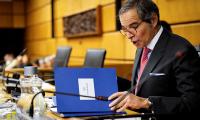You can’t trash a house and then complain it’s looking bad. Which is why it has become rather tiresome to hear the PTI chairman bemoan the absence of stability as the primary reason to hold fresh elections. This argument runs out of steam fairly quickly when measured against the logic of what – or who, as it turns out – is the cause of this instability.
The logic: the federal government is struggling to govern which is causing markets to remain volatile and the running of the state difficult. This is generating instability in the country which is causing further problems of governance and sending the economy into a tailspin. Therefore, early elections are the only solution to this quagmire.
The cyclical nature of this argument would be almost sweet in its naivete if it weren’t so disingenuous.
Here’s why:
When constitutional processes are followed they inject an element of predictability into the situation. The vote of no-confidence against the PTI government did not derail the democratic system, or dynamite due process of parliamentary proceedings, or threaten to demolish legislative precedence.
The instability sprouted from the way the PTI government of the day responded to this parliamentary move. It had two choices at that time: first, opt for stability by having the speaker conduct the voting, accept the result, sit on the opposition benches, put up a spirited fight in the National Assembly and prepare for the general elections; or, aim to unleash instability knowing full well the impact on the political and economic situation.
The PTI chose option two: have the speaker violate the constitution, have the president dissolve the National Assembly, and have the party adopt an inflammable conspiracy theory about the US engineering Imran Khan’s ouster from the government. All three of these well-thought out actions unleashed an avalanche of uncertainty and instability that kept manifesting itself in event after event over the next seven months.
By violating the constitution in such a brazen manner, the PTI leadership dragged the Supreme Court into the vortex of this instability. By refusing to act upon the judgement of the court, and by unleashing a torrent of abuse against the judges, the party brought the constitutional system of governance – a major part of which is structured on the agreement that court judgements will be implemented – to the brink of disaster. All this was avoidable. But it was not intended to be. The crisis was engineered to generate a wave of instability.
While the refusal to accept constitutional and legal pronouncements, and then tendering resignations from the National Assembly were meant to trigger institutional turbulence, the PTI leadership firebombed the electorate with a US conspiracy fairy tale that was meant to destabilize the streets. It was a choice that the party made – a carefully considered and deliberate one, it must be said – to take an untruth and build a combustible narrative around it in a bid to fuel chaos. The instability that ensued over the following months was not an accidental by-product of the PTI’s actions but the intended outcome.
If this wasn’t enough to create volatility in the system, the PTI went ahead with a series of steps that were aimed specifically at unhinging the entire edifice of politics and governance.
One, the party undertook the first ‘long march’ that aimed to ‘drag down’ the government by force. The fiery rhetoric and aggressive mobilization, and the chaos in the federal capital with incensed party supporters burning trees and damaging public property generated political, economic and administrative instability to ensure the system remained hostage to the event.
Two, PTI leaders started spreading panic in the markets by deliberately saying that the country was about to default. Former finance minister Shaukat Tarin was caught on tape telling the finance ministers of Punjab and Khyber Pakhtunkhwa to take steps that would sabotage the federal government’s negotiations with the IMF. Generating economic instability was a policy choice that the PTI made, not an unintended spinoff of a half-baked policy.
Three, PTI leaders deliberately weaponized the tragic murder of journalist Arshad Sharif by irresponsibly pointing fingers at the state. They went a step further in this blame game after the condemnable assassination attempt on the PTI chairman. These were choices made with cold logic, and not impulsive reactions in the heat of the moment.
Four, the November long march and the threats to force down the government through sheer street power pouring into the federal capital kept the country hostage for weeks on end. The fact that the threat whimpered into nothingness could not minimize the damaging impact it had on the delicate economic situation.
Five, the PTI chairman’s announcement of his intent to dissolve the Punjab and KP assemblies unleashed another wave of political uncertainty that is still keeping the situation unstable. Even though the PTI has been forced on the defensive and may have committed another political mistake, the fact remains that the party chose to inject this turbulence into the system in order to bring the government to its knees.
None of these steps has resulted in the PTI getting what it so desperately wants: fresh elections. But the cost in economic and governance terms for the country has been steep.
Many arguments can be made about decisions taken, or not taken, by the government since it assumed office in April this year, but one thing it cannot be accused of is being responsible for instability in the country. The framing of the PTI argument about instability being the primary reason for the calling of fresh elections is therefore deeply flawed.
There are two key issues now that will define what happens in the coming days. First, is the PTI willing to give up its scorched earth policy after failing to achieve its objective through wave upon wave of engineered and orchestrated instability; and second, can all political stakeholders agree that it is better to take steps that will ensure free, fair and transparent elections instead of battling out a zero-sum outcome that serves no one, least of all Pakistan?
The situation in Punjab will indicate which way things are headed. It has shown yet again that democracy is not an easy system to navigate through political conflicts but that it is the only system that can generate negotiated outcomes without imperiling the system as whole. Accepting and acknowledging this fact requires embracing politics of maturity and soberness. The delayed understanding of such an approach by any stakeholder can extract a steep cost from the country. We may have already paid a large sum.
In this polarized environment it may sound implausible, improbable and perhaps even impossible that the PTI chairman would opt to quell the instability that he has generated over the last few months and focus on ensuring that the next five years provide a better environment for economic and political improvement. He may think he has a choice today, just like he thought he had a choice when he ordered the then speaker to violate the constitution, and when he pulled the conspiracy rabbit out of his hat.
In hindsight, it is clear that the choices he made then were not really choices. The only choice was the choice he did not choose. He has a chance again today to right the wrongs of the last seven months by choosing to make the next seven months an example of mature decision-making and not half-baked politics.
Will he choose wisely?
The writer is the special assistant to the prime minister on public policy and strategic communication. He tweets @fahdhusain
Partnership between Pakistan and China in media and culture reflects shared commitment to strengthening bilateral...
This article focuses on single error committed by our respected judiciary which haunts me more than I would care to...
US still leads world in military spending and ability to project military power across globe
On July 3, UNGA adopted another resolution advocating for “free, open, inclusive” environment for AI development
Data, today, defines how we make decisions with tools allowing us to analyse experience more precisely
But if history has shown us anything, it is that rivals can eventually unite when stakes are high enough







